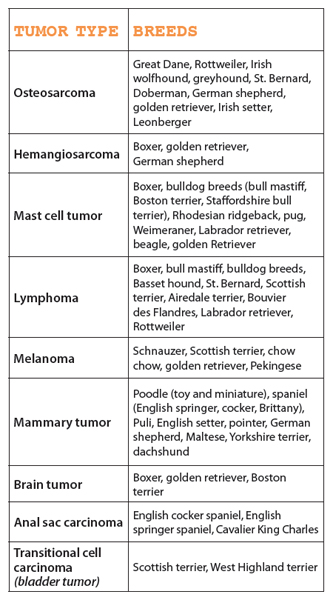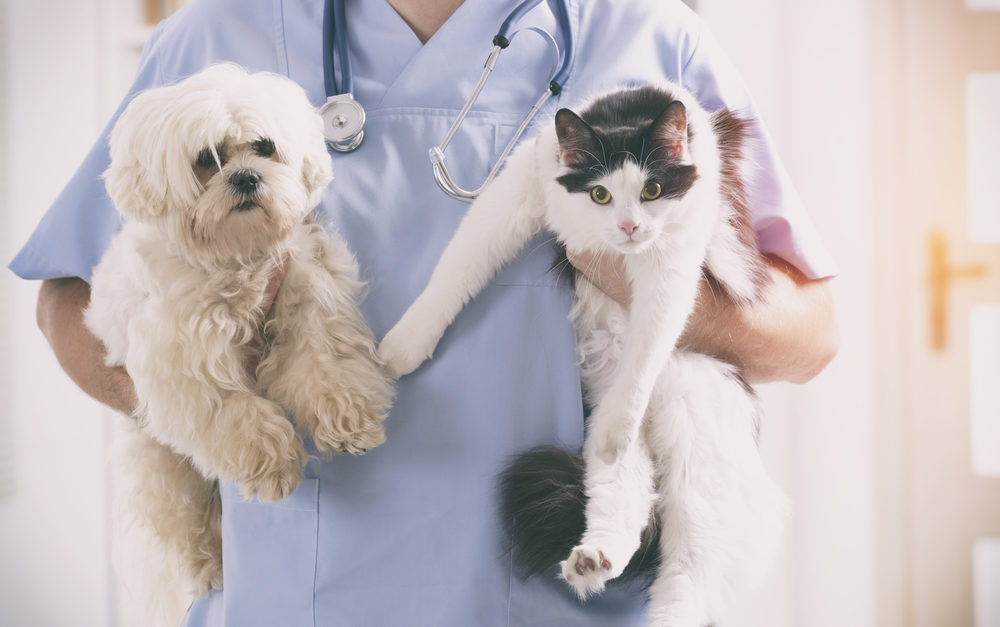Certain breeds seem more susceptible to cancer, and both genetics and environment play a role.
Have you ever heard it said that mutts are healthier than purebreds? Well, that may not be true, but when it comes to cancer mixed breeds might have the advantage. In recent years, researchers have been trying to answer the question: “Are certain breeds more prone to cancer? If so, why?”
Prevalence and risk factors
Cancer in dogs isn’t new, but it seems as if its prevalence is increasing. Overall, approximately one in four dogs is diagnosed with some type of cancer during his/her lifetime. A 2010 study found that 27% of purebreds develop cancer, while an older study from 2000 found that 45% of dogs over ten years of age get cancer.
While rates may appear to be growing, there are additional factors to consider. Animals are living longer, and since it is more predominant in seniors, it makes sense that we are seeing more of the disease. Veterinary care is also improving by leaps and bounds, and offers less invasive and more sensitive methods for diagnosing the disease. People are also more aware of their dogs’ health than they were in the past, and are more vigilant about finding out what’s wrong with their companions, and about treating the problem.
“Twenty years ago, we weren’t diagnosing cancer, because people weren’t willing to treat it,” says veterinary oncology specialist Dr. Jennifer Kim. “Dogs died of ‘old age’, but in reality, they died of something. I don’t think we are seeing more cancer; I think the increased number of cases is the result of clients wanting to know if their dogs have cancer, and of the veterinarians’ ability to diagnose it.”
It may be impossible to pinpoint the exact causes of cancer, although there are some well-documented risk factors in humans. The combination of genetics, which predisposes an individual to the disease, along with environmental exposures to carcinogens, such as cigarette smoke, is a common recipe for formation.
Dogs exist closely with humans, so they are exposed to the same environments with their potentially harmful substances. But they also have known genetic predispositions to certain types of the disease. The genetic differences between the individuals of any specific breed are small compared with the canine population overall. Selective breeding for exaggerated physical traits may increase the risk of selecting genes with mutations (alterations to the genetic code that alters its function), thereby predisposing dogs to disease.
 Most commonly, risk increases when mutations occur in tumor-suppressor genes whose natural function is to fight cancer formation. A mutation in any gene has the potential to increase the risk of disease.
Most commonly, risk increases when mutations occur in tumor-suppressor genes whose natural function is to fight cancer formation. A mutation in any gene has the potential to increase the risk of disease.
It is difficult to determine the true risk of cancer in some breeds. For example, if a breed isn’t “popular”, there may be insufficient data on its cancer risk. In addition, breeds with shorter lifespans (due to other conditions unrelated to cancer) are more challenging to study with regards to their cancer risk. Since cancer is generally a disease of older dogs, these breeds don’t tend to have much cancer. The bulldog is an example; this breed is regarded as having a low cancer risk, but at the same time, isn’t as long-lived as many other breeds.
Specific cancers common to dogs
1. Osteosarcoma, or bone cancer, is associated with rapid bone growth in early development. Researchers also suggest that bone stress due to weight-bearing and exercise leads to micro-fractures, which can lead to tumor formation later in life. There may also be possible links to growth hormones, but there is little evidence to support this hypothesis.
Osteosarcoma does not appear to arise from a genetic predisposition; it is more likely that larger breeds have a higher risk because of their weight and size. One study found that retired greyhounds had a greater risk of this type of cancer, but it didn’t find the same risk in whippets, their close genetic cousins, most likely because whippets are smaller.
2. Hemangiosarcoma involves a malignant tumor that arises from blood vessels. It most commonly occurs in the spleen, liver, and more rarely in the skin. It represents 7% of all canine tumors. While environmental factors may be involved, it appears likely that this cancer is linked to mutations in several genes that suppress tumor growth.
However, tumors in golden retrievers seem to have a specific genetic profile difference from those of other breeds. The high incidence of disease in this breed appears to be a recent phenomenon; a study in 1988 did not cite golden retrievers as predisposed to this type of tumor. Interestingly, similar patterns of high incidence have not been reported in the UK or Europe, offering researchers a unique opportunity to investigate the differences in genetics between European and American lineages.
3. Mast cell tumors are relatively common tumors, comprising between 7% to 20% of all skin tumors. Boxers and bulldog breeds tend to have lower grade (less aggressive) tumors; Labrador retrievers have more aggressive tumors; and golden retrievers tend to have multiple tumors. While this suggests that different breeds have different genetic predispositions for this type of cancer and how it affects them, no definitive gene or genes have been linked to this disease.
4. Lymphoma is the most common hematopoietic (arising from blood cells) tumor type in dogs. There are reports of clusters of the disease occurring within purebred families, in which many dogs from the same lineage are diagnosed and have a close ancestor that was also diagnosed. This suggests that lymphoma is not only partially genetic in origin, but that familial associations may further increase the risk of disease in certain lines.








